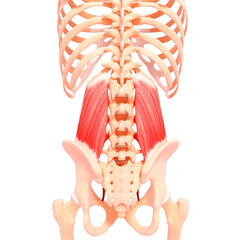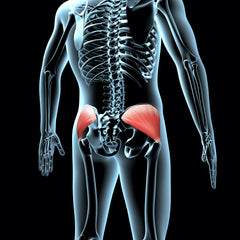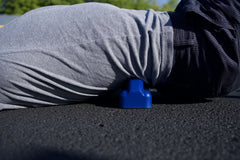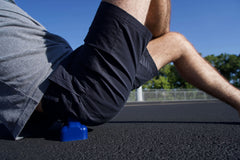Lower back pain is hands down one of the most debilitating types of pain. If you have had a low back pain episode, you get it. Your pain consumes your thoughts and dominates your lifestyle. My goal here is to get you to understand the potential mechanism of your pain, and get you on an actionable path to low back pain relief.
Back pain brought on by lifting could have an easier fix than you might think. When lifting heavy weights or awkward objects, a predictable group of muscles tends to tighten up and guard the spine from injury. Muscle tightness and spasms due to guarding is a healthy short term solution to prevent serious spinal injury, but complications arise when your muscles are still locked up a week, month, or even a year after the initial event. In this article I'm going to help you understand which muscles are likely locked up from your lifting injury, and how to release them to help get you out of lower back pain.

Quadratus Lumborum & Gluteus Medius
If you haven't heard of these muscles, that is a good sign - you have not yet been desperate enough to dive into the anatomy of muscle induced lower back pain.
Quadratus Lumborum (QL): Quadratus Lumborum is a deep low back muscle that is crucial for spinal stability, side bending, and heavy lifting. The QL muscle connects from the top of the hip to the lowest rib, and also connects to the lumbar vertebrae in criss-cross like patterns [1]. For more information on the QL muscle check out this blog post.

Quadratus Lumborum (QL) Muscle
Gluteus Medius: Gluteus Medius is an upper glute muscle that is essential for single-leg stability, walking, running, and lifting. If you stand on your right leg only, your right Gluteus Medius fires to prevent you from falling to your left side [1]. Check out this post for more information on the Gluteus Medius muscle.

Gluteus Medius Muscle
Lower Back Pain From QL and Gluteus Medius
Quadratus Lumborum and Gluteus Medius can both refer pain to the lower back. Tightness/spasms/trigger points in each muscle will cause pain during lifting, particularly with heavy or awkward objects. If you have difficulty standing on your feet too long, lifting uneven objects like boxes and chairs, or carrying a moderate load that should be easy for you - QL and Gluteus Medius should be examined for trigger points and tightness.

Referred Pain Patterns of the QL Muscle (bright red) [1]

Lower Back Pain From Lifting Relief
To escape the treacherous low back pain brought on by the QL and Gluteus Medius muscles, you will want to perform targeted deep tissue massage. Effective deep massage will break up any trigger points and tightness in the muscle that is contributing to your pain. I would recommend working these muscles 2 minutes each, twice per day, for 3 days to break up the tissue.
For self release of QL and Gluteus Medius contributing to back pain, QL Claw is great. QL Claw was designed to release the 5 muscles that contribute to low back pain, with QL and Gluteus Medius both on that list. Another beauty of QL Claw is its versatility. QL Claw can release nearly every muscle in the body, including the 3 other muscles that may give you back pain down the road, and 2 more muscles that may give you hip pain.

QL Release Using the QL Claw Device

Gluteus Medius Release Using the QL Claw Device
After Deep Tissue Release
After relieving your QL and Gluteus Medius muscles of unwanted tightness and trigger points, it is important to strengthen these muscles to prevent future injury. For strengthening the core and trunk - which includes QL and Gluteus Medius - I love the McGill big 3 exercises. Implementing deep tissue release and strengthening into your regimen may be the missing link to relieve your lower back pain from lifting.
Take Control of Your Pain and Own a QL Claw Today!
Sources:
[1] Donnelly, Joseph M. Travell, Simons & Simons Myofascial Pain and Dysfunction: the Trigger Point Manual. 3rd ed., Wolters Kluwer Health, 2019.


